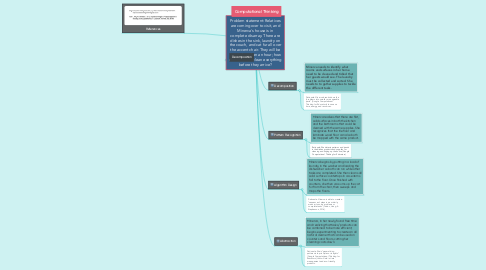Problem statement: Relatives are coming over to visit, and Minerva's house is in complete disarray. There are dishes in the sink, laundry on the couch, and cat fur all over the accent chair. They will be here in less than an hour; how does Minerva clean everything before they arrive?
by Lori Davis

1. Decomposition
2. References
3. Computational Thinking
4. Abstraction
4.1. Minerva, in her newly found free time and realizing that tasks/products can be combined to be more efficient, begins experimenting to create an all natural cleaner that can be used on counters and floors, cutting her cleaning costs down.
4.2. Rationale: She is "generalizing patterns into principles or insights" (Google Computational Thinking for Educators) that will aid in time management and eco-friendly products.
5. Pattern Recognition
5.1. Minerva realizes that there are flat, solid surfaces in both the kitchen and the bathrooms that could be cleaned with the same supplies. She recognizes that the tile floor and laminate wood floor can also both be mopped with the same product.
5.2. Rationale: She detects patterns and trends in the kitchen products and supplies for cleaning and tidying up the house (Google Computational Thinking for Educators).
6. Algorithm Design
6.1. Minerva begins by putting in a load of laundry in the washer and loading the dishwasher so both can run while other tasks are completed. She then cleans all solid surface countertops in case items fall to the floor. Once finished with counters, she then vacuums up the cat fur from the chair, then sweeps and mops the floors.
6.2. Rationale: Minerva is able to create a "sequence of steps in an orderly manner to solve problems or complete tasks" (Yadav, Hong, & Stephenson, 2016).
7. Decomposition
7.1. Minerva needs to identify what rooms and surfaces in her home need to be cleaned and tidied that her guests would see. The laundry must be collected and sorted. She needs to to gather supplies to tackle the different tasks.
7.2. Rationale: Minerva breaks down the "problems into smaller, manageable parts" (Google Computational Thinking for Educators) to save on time, energy, and resources.



